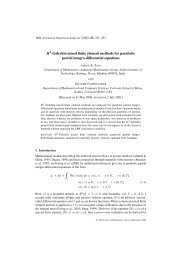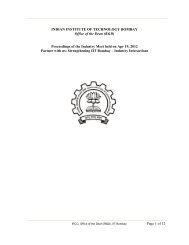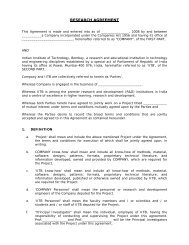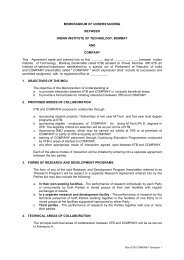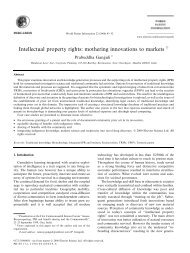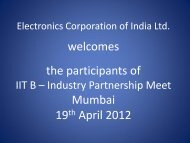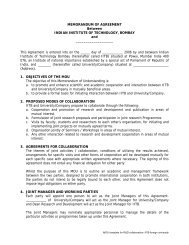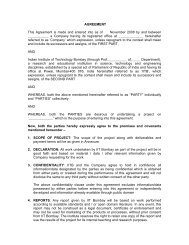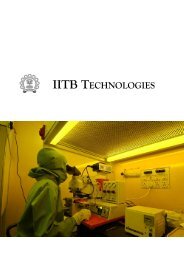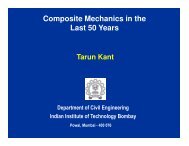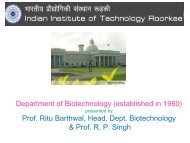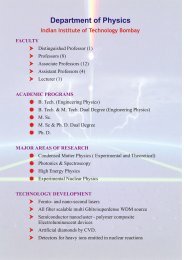Title : The art of making babies - IRCC
Title : The art of making babies - IRCC
Title : The art of making babies - IRCC
Create successful ePaper yourself
Turn your PDF publications into a flip-book with our unique Google optimized e-Paper software.
<strong>The</strong> ART <strong>of</strong> <strong>making</strong> <strong>babies</strong>:<br />
Nobel prize winning discovery 2010<br />
Deepak Modi<br />
NIRRH<br />
Mumbai 12<br />
deepaknmodi@yahoo.com
Infertility<br />
Definition:<br />
<strong>The</strong> inability to conceive following unprotected sexual<br />
intercourse<br />
1 1 year (age < 35) or 6 months (age >35)<br />
10-15% <strong>of</strong> world population is infertile<br />
6.1 million couples worldwide experience involuntary childlessness
Some facts<br />
Infertility problems<br />
A study revealed that 49% <strong>of</strong> women and 15%<br />
<strong>of</strong> men described infertility as the most upsetting<br />
event <strong>of</strong> their lives<br />
About 60% <strong>of</strong> infertility patients suffered from an<br />
Adjustment Disorder<br />
13% <strong>of</strong> infertile women had suicidal ideation<br />
Involuntary childlessness is a major social<br />
problem affecting the psychological and emotional<br />
wellbeing <strong>of</strong> the couple
What are the causes <strong>of</strong> infertility ?
Human reproductive system<br />
Female system<br />
Male system<br />
Makes the female gamete<br />
Oocyte/egg<br />
Physically supports pregnancy<br />
Uterus/womb<br />
Makes the male gamete<br />
Sperm
• Failure to make eggs<br />
• Failure <strong>of</strong> the transport <strong>of</strong> the<br />
eggs and support<br />
fertilization<br />
• Abnormal uterus to support<br />
pregnancy<br />
Causes <strong>of</strong> female and male infertility<br />
Absent or<br />
blocked tubes<br />
Failure <strong>of</strong> sperm production<br />
Failure <strong>of</strong><br />
sperm<br />
maturation
<strong>The</strong> problem ….<br />
<strong>The</strong> classical methods <strong>of</strong> infertility treatment<br />
include<br />
Hormonal therapies<br />
Surgery<br />
Poor success rate<br />
Limited to only a subset <strong>of</strong> the spectrum and<br />
most couples remain untreated
Initial work <strong>of</strong> Pr<strong>of</strong> Edward (1957)<br />
Immature or mature mice<br />
Inject with hormones <strong>of</strong> the pituitary<br />
PMSG/HMG<br />
Ovaries mature and make<br />
large number <strong>of</strong> eggs<br />
Mate with normal males<br />
Large number <strong>of</strong> NORMAL and FERTILE<br />
Conclusions<br />
<strong>of</strong>fsprings are born<br />
• Exogenous hormones promote ovary maturation<br />
• Matured oocytes produce normal viable <strong>of</strong>fspring's<br />
• Can this be applied to infertile human females ??
Hormone administrations in humans ………..<br />
Studies done with pituitary extracts<br />
Multiple erratic ovulations<br />
Multiple pregnancies<br />
Transmission <strong>of</strong> viruses from pituitary extracts<br />
Clinical trials suspended !!<br />
CAN OVARIES BE MATURED IN VITRO ??
What did he think ?<br />
If ovarian follicles can be matured in a<br />
lab dish the eggs could be fertilized in<br />
the petridish with the sperm and the<br />
resulting zygotes given to the mothers<br />
Requirement <strong>of</strong><br />
matured eggs
What did he do .. (1957-1960)<br />
Oocytes from mice, rats and hamsters did<br />
mature within 12 hours.<br />
Sheep, cow, rhesus monkey and baboon<br />
oocytes did not<br />
Collaborated with a gynecologist Dr Molly<br />
Rose and obtained slices <strong>of</strong> human ovaries<br />
Oocytes did not mature in vitro for two<br />
years under several experimental<br />
conditions
One fine day …..<br />
Extending the culture period from 12hr in mice to<br />
37 hrs in humans matured the eggs !!<br />
Used the eggs to fertilize them in vitro<br />
Collaborated with Pr<strong>of</strong> Bavister at Cambridge<br />
and inseminated sperm with in vitro matured<br />
eggs<br />
Edwards, R.G. Meiosis in ovarian oocytes <strong>of</strong> adult mammals. Nature 196, 446–450 (1972).<br />
Edwards, R.G. Maturation in vitro <strong>of</strong> human ovarian oocytes. Lancet 208, 39–351 (1965).
Very first images <strong>of</strong> in vitro developed<br />
human embryos<br />
Fertilization<br />
First cleavage<br />
Morula<br />
Blastocysts<br />
Edwards, R.G., Bavister, B.D. & Steptoe, P.C. Early stages <strong>of</strong> human fertilization in vitro <strong>of</strong> human oocytes matured in vitro. Nature<br />
221, 632–635 (1969). Nature 231, 87–91 (1971).<br />
Steptoe, P.C., Edwards, R.G. & Purdy, J.M. Human blastocysts grown in culture. Nature 229, 132–133 (1971).
Aftermath <strong>of</strong> the discovery<br />
Met with lot <strong>of</strong> opposition<br />
from churches<br />
Viewed with suspicion<br />
Accused <strong>of</strong> playing GOD<br />
Funding stopped<br />
But he continued to work<br />
on private funding
Need <strong>of</strong> the hour for translation <strong>of</strong> this<br />
lab finding into practice……<br />
A gynecologist (Dr Molly Rose)<br />
An embryologist (himself)<br />
A trained personnel who could remove<br />
follicles from the ovary non surgically<br />
Collaborated with Pr<strong>of</strong> Patrick laparoscopy specialist<br />
at the Oldham and District General Hospital<br />
Patients<br />
Money
<strong>The</strong> stage in 1972-1976<br />
Patients recruited<br />
Given mild hormones for ovarian stimulation<br />
Eggs collected by laproscopy surgery<br />
In seminated in vitro<br />
Large number <strong>of</strong> unsuccessful trials<br />
Endocrine imbalances in patients<br />
Discontinuation <strong>of</strong> hormonally stimulated cycles
1976-77<br />
Women in natural cycles<br />
Collected oocytes<br />
Quick insemination<br />
Transfer back to the uterus<br />
<strong>The</strong> second patient Lessy Brown<br />
became pregnant
<strong>The</strong> finale …… 26 July 1978 Oldham (UK)<br />
Louise Joy Brown was born on 26 July<br />
1978 on a momentous evening in Oldham<br />
In utero growtrh <strong>of</strong> baby brown<br />
Louise Brown’s birth marked the end <strong>of</strong> the<br />
beginning <strong>of</strong>human IVF, acclaimed at the Royal<br />
College <strong>of</strong> Obstetricians and Gynaecologists.
Assisted Reproductive Technology ART
Way forward and improvements<br />
With advent <strong>of</strong> purified gonadotropins its<br />
possible perform controlled superovulation in<br />
women<br />
Application <strong>of</strong> ultrasound to monitor ovulation<br />
and egg retrieval<br />
Sensitive assays to detect pregnancies (hCG<br />
assay)
Consultation<br />
and<br />
evaluation<br />
A typical IVF cycle<br />
Ovarian hyper<br />
stimulation for<br />
multiple ovulations<br />
Collection <strong>of</strong> many eggs<br />
Collection <strong>of</strong><br />
husbands<br />
sperm<br />
> 4 million children are born post IVF as <strong>of</strong> today<br />
Pregnancy<br />
IVF
Nobel prize in physiology and medicine 2010<br />
<strong>The</strong> Father <strong>of</strong> the Test Tube Baby: Robert G. Edwards<br />
Citation:<br />
Robert G. Edwards, the 2010 Nobel Laureate in<br />
Physiology or Medicine, battled societal and<br />
establishment resistance to his development <strong>of</strong> the in<br />
vitro fertilization procedure, which has so far led to the<br />
birth <strong>of</strong> around 4 million people<br />
Born 27 September 1925 (1925-09-27) Manchester<br />
United Kingdom<br />
Institutions: University <strong>of</strong> Cambridge<br />
Alma mater: University <strong>of</strong> Wales, Bangor<br />
University <strong>of</strong> Edinburgh<br />
Known for reproductive medicine in-vitro fertilization
Advanced ART<br />
Cryopreservation<br />
Intracytoplasmic Sperm Injection (ICSI)<br />
Preimplantation Genetic Diagnosis (PGD)<br />
Gamete donation and surrogate motherhood
Freezing - cryopreservation<br />
Can store and preserve<br />
Sperm<br />
Embryos<br />
Eggs<br />
Ovarian tissue<br />
Over a million healthy births are reported using cryopreservation in IVF
Indications<br />
Gametes/surplus embryos to be used<br />
for subsequent cycles<br />
Delay parenthood<br />
Cancer therapy<br />
Donations
Cryopreservation in cancer survivors<br />
Young adolescents on cancer therapy –<br />
loss <strong>of</strong> germ cells in gonads<br />
Remission-Infertility<br />
If eggs/sperm are cryopreserved these<br />
can be used for biological parenthood<br />
If married embryos are cryopreserved
Intracytoplasmic sperm injection ICSI<br />
Microinjection <strong>of</strong> sperm in to the egg<br />
Can use testicular sperm even from men with testicular<br />
failure<br />
A revolution in field <strong>of</strong> ART for male factor infertiltiy<br />
Indications for ICSI<br />
Poor quality immotile sperm<br />
Abnormally shaped sperm<br />
No sperm in semen<br />
Over a million healthy births are reported post ICSI
Genetic Testing<br />
Postnatal<br />
Prenatal<br />
Prevention <strong>of</strong> birth <strong>of</strong> a genetically<br />
affected child<br />
Pregnancy with genetically affected child post IVF is<br />
traumatic emotional, social and financial trouble<br />
Religious and social issues against abortions<br />
Is it possible to screen embryos for specific genetic<br />
defects prior to implantation ??
Genetic testing<br />
Hereditary disease (thalassemia,<br />
haemophilia)<br />
Chromosome abnormalities (with<br />
advanced maternal age)<br />
Balanced chromosomal aberrations in<br />
parents
Which Embryo is Disease-Free?
Preimplantation Genetic Diagnosis<br />
(PGD) – the newest ART<br />
PGD marries genetic technology and<br />
IVF technology<br />
Can test embryos for genetic<br />
abnormalities prior to implantation<br />
<strong>The</strong> newest patient is the embryo !
Day 3 IVF Embryo<br />
<br />
<br />
<br />
Single cell biopsy<br />
Fluorescence in situ hybridization (FISH)<br />
Aneuploidy/translocations (5-10<br />
chromosomes)<br />
Polymerase chain reaction (PCR)<br />
Specific single gene disorders<br />
First clinical application described by<br />
Handyside, Winston, and Hughes in<br />
1990<br />
Till date, estimated >5000 PGD-defined<br />
live births (ESHRE Task Force)
Options for parenthood: Gamete donation<br />
<br />
Egg donation<br />
<br />
<br />
<br />
<br />
Post menopausal women<br />
Premature ovarian failure<br />
Chromosomal abnormality (Turner syndrome)<br />
Gay couples<br />
<br />
Sperm donation<br />
<br />
<br />
<br />
Complete testicular failure<br />
Chromosomal aberrations (Klinefelter syndrome)<br />
Lesbian couples<br />
<br />
Surrogate mothers : Biological parents using womb <strong>of</strong> a related/unrelated women<br />
<br />
<br />
<br />
Women with uterine defects<br />
Immunological defects<br />
Gay couples
Extension to human embryo research and<br />
Embryonic Stem Cells<br />
<strong>The</strong> availability <strong>of</strong><br />
human embryos has<br />
expanded our<br />
understanding in the<br />
areas <strong>of</strong><br />
Human fertilization<br />
Early embryonic growth<br />
and cleavages<br />
Early events in mitosis<br />
Embryonic stem cells
IVF milestones<br />
1978 Louise Joy Brown, first IVF baby<br />
1981 Elizabeth Carr, first IVF baby in USA<br />
1983 First birth after egg donation<br />
1985 First birth from cryopreserved embryo<br />
1985 Transvaginal ultrasound for follicle monitoring<br />
1990 First report <strong>of</strong> births after PGD<br />
1990 First report <strong>of</strong> egg donation to older mothers<br />
1992 First human birth after ICSI<br />
2010 NOBEL PRIZE IN PHYSIOLOGY AND MEDICINE
…… October 3, 1978 Kolkata<br />
(then Calcutta -India)
67 days after birth <strong>of</strong> baby Brown…….<br />
Was born a girl Kanupriya to a Marwari<br />
couple in calcutta<br />
Durga alias Kanupriya was too born after<br />
IVF developed endogenously and<br />
independently in India<br />
With the pioneering work and untiring<br />
efforts <strong>of</strong> Dr Shubash Mukopadhaya
Dr Shubas Mukopadhaya
Dr Shubas Mukopadhaya’s records<br />
<br />
<br />
<br />
<br />
<br />
<br />
Ovarian stimulation: 19-10-1978 treated Mrs Agarwal with hMG 76 ampoules given<br />
twice a day and on alternate days and st<strong>art</strong>ing from day 3 to day 9 <strong>of</strong> the cycle.<br />
given 6000 I.U. <strong>of</strong> hCG on day 11 <strong>of</strong> the cycle and she was subjected to oocyte<br />
aspiration some 48h later (this protocol is exactly followed today !!)<br />
Oocyte aspiration done by a minor incision (near pouch <strong>of</strong> Douglas) and aspirated<br />
5 oocytes<br />
Inseminated and grew them till 8 cell stage<br />
Cryopreserved for 53 days<br />
Transferred to Mrs Agrawals womb<br />
Pregnancy ensured and Kanupriya was born
Dr Mukopadhaya<br />
Stimulated cycle<br />
Multiple oocyte<br />
aspiration<br />
Insemination with<br />
low sperm count<br />
Cryopreservation<br />
Transfer in<br />
subsequent cycle<br />
Live birth on 3 rd Oct<br />
1978<br />
Where did we<br />
miss the Nobel<br />
prize bus ??<br />
Dr Edward<br />
Natural cycle<br />
Single oocyte<br />
aspiration<br />
Insemination with<br />
normal sperm count<br />
No cryopreservation<br />
Same cycle transfer<br />
Live birth on 26 July<br />
1978<br />
A parallel independent discovery in two different continents !!!
But…<br />
<strong>The</strong> discovery was marred with criticism and disbelief<br />
An ‘expert committee’ appointed by the Govt <strong>of</strong> West Bengal under the<br />
medical association presided over by a Radio physicist and with a<br />
gynecologist, a psychologist, a physicist and a neurologist !<br />
<strong>The</strong> Committee put forward its final verdict (1978)<br />
No documentation <strong>of</strong> the treatment, embryos etc etc<br />
No previous pro<strong>of</strong>-<strong>of</strong>-principal animal experiments<br />
No biochemical pro<strong>of</strong> that Kanupriya was born <strong>of</strong> IVF and not natural cycle !<br />
“Everything that Dr. Mukhopadhyay claims is bogus.”
1980 : Dr. Subhash Mukhopadhyay was denied passport to go to Kyoto (Japan)<br />
to present his paper on IVF<br />
He was then transferred to eye hospital, where he suffered a he<strong>art</strong> attack<br />
Faced social ostracization, bureaucratic negligence, reprimand and insult and<br />
refusal <strong>of</strong> the Government <strong>of</strong> India to allow him to attend international<br />
conferences<br />
1981: He committed suicide on 19 June<br />
1981: His work on cropreservation was recognized and used by Pr<strong>of</strong> Jones the<br />
father <strong>of</strong> cryobiology in IVF !<br />
Movie: Ek Doctor Ki Maut by Tapan Ghosh
15 years later ……1995-2008<br />
1996 : T.C. Anand Kumar, leader <strong>of</strong> the group which produced the first document test tube<br />
baby in country in Mumbai 1986, gains access to the notes <strong>of</strong> Dr. Subhash Mukhopadhyay<br />
1997 : T.C. Anand Kumar, takes a year to study them and writes first paper on Dr. Subhash<br />
Mukhopadhyay achievements<br />
2002 : Indian Council for Medical Research (ICMR) appoints a 12 member committee<br />
2003 : Commitee accepts Dr. Subhash Mukhopadhyay's claim<br />
2004 : IVF specialist across the country challenge the document.<br />
2005 : ICMR upholds the claim, honours Durga (Kanupriya Agarwal) in first public meeting in<br />
Bangalore<br />
April 2008 : Dr. Subhash Mukhopadhyay's achievement finds <strong>of</strong>ficial stamp <strong>of</strong><br />
approval
<strong>The</strong> words from the dearer…<br />
"I certainly do not want to be a poster girl <strong>of</strong> the IVF industry, which undermined Dr<br />
Mukhopadhyay's achievement for 30 years," says Kanupriya, breaking her silence for the<br />
first time. "I am not a trophy but I am proud to be the living example <strong>of</strong> work <strong>of</strong> a genius.“<br />
Kanupriya says "My parents did a wonderful job <strong>of</strong> keeping all the pressure away and<br />
helping me grow as a mature, reasonable individual," she says. "It was not easy for them,<br />
they were made to feel like accomplices <strong>of</strong> Dr Mukhopadhyay in his misdeed. <strong>The</strong>re were<br />
insinuations <strong>of</strong> the worst kind“ Looking at the brighter side, she says: "I feel truth has<br />
prevailed.“<br />
Even though Dr Subhash Mukhopadhyay was belatedly honoured it failed to bring any<br />
cheer to his wife. Namita Mukhopadhyay's has been paralysed and battling with ignominy<br />
and neglect ever and is confined to her bed<br />
"We decided not to st<strong>art</strong> a family as he (Subhas) wanted to complete his research. He was a<br />
very emotional person and dedicated himself to his work. But he never got any support<br />
either from the government or from his peers," says Namita.
<strong>The</strong> pioneers in ART <strong>of</strong> <strong>making</strong> <strong>babies</strong> !!
Lets work together for a better<br />
society….<br />
Lets not make more Dr Subas…..<br />
Lets not miss a Noble prize again……<br />
THANK YOU
History <strong>of</strong> Infertility<br />
First written document dealing with infertility<br />
may be found in the Kahoun papyrus (oldest<br />
Egyptian medical text), dated to 2200-1950<br />
BC<br />
<strong>The</strong> early attribution <strong>of</strong> infertility to women<br />
persisted for centuries and was <strong>of</strong>ten<br />
considered divine punishment<br />
<strong>The</strong> only solution to infertility was prayer – to<br />
Egyptian Isis, Phoenician Ast<strong>art</strong>e, Greek<br />
Aphrodite, or Roman Venus
Procedure for preimplantation<br />
genetic diagnosis<br />
1. IVF cycle<br />
2. 8-cell embryo at Day 3<br />
3. Biopsy embryo ( micromanipulator)<br />
4. Fix blastomere<br />
5. Study genetic composition <strong>of</strong><br />
blastomere using genetic probes<br />
6. Transfer selected embryos into uterus
Infertile Couples: A new group <strong>of</strong><br />
patients<br />
• Total fertility rates reclining<br />
<strong>The</strong> birth rate has fallen to almost half in the last 50 years<br />
piteDehttp://www.rickety.us/2009/10/world-total-fertility-rate-declines/



